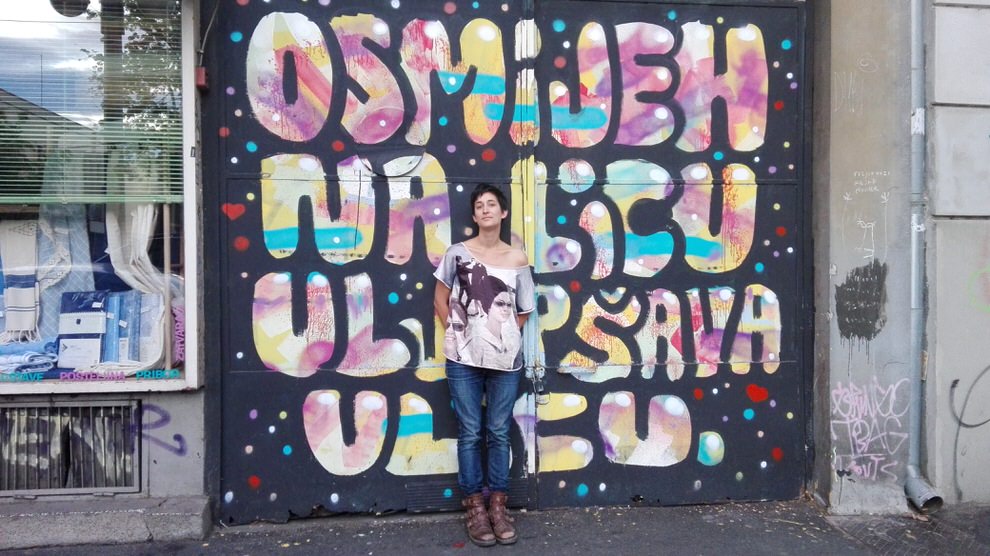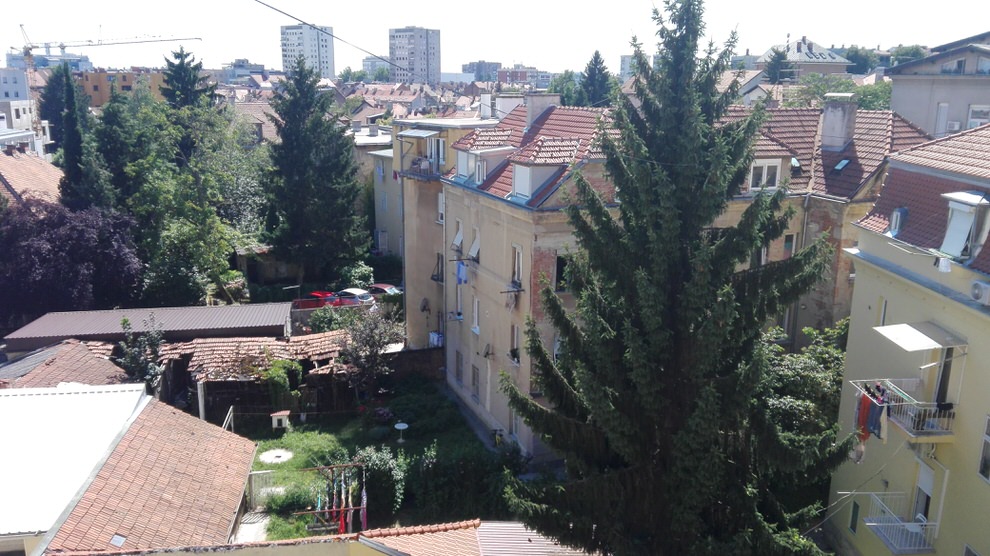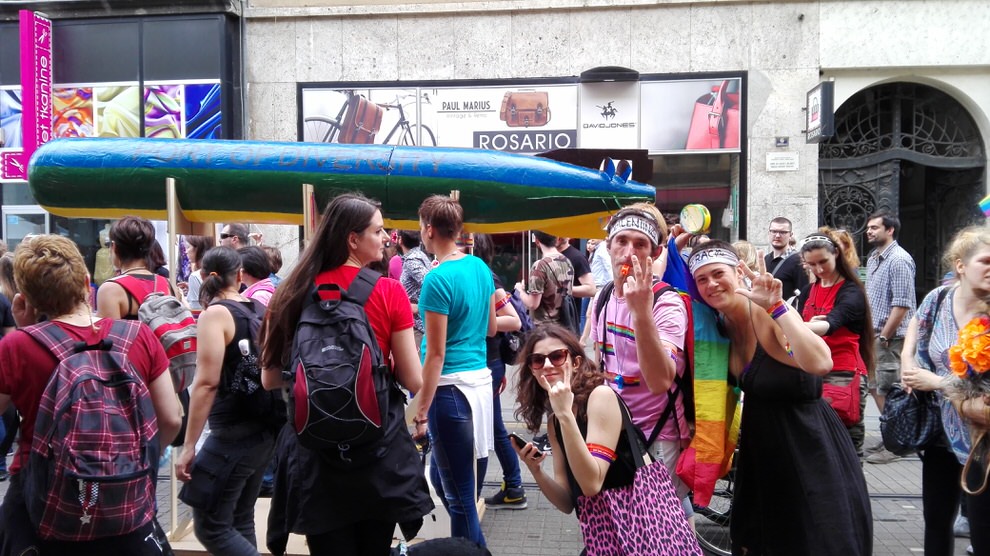
Jana Perkovic: Zagreb, Croatia
Reason for travelling
A Croatian person always has a reason to travel to Zagreb, be it for family visits, or to see their dentist.
An art love affair
I come from Rijeka, a smaller and more liberal city on the Croatian coast. However, my love affair with theatre was born in Zagreb. During my high-school years, for reasons to do with my small country’s economy and geography, my mum figured out that it was more expedient to get me an orthodontist in Zagreb, so every fortnight I would miss a Friday of school and trudge to my country’s proud capital, to have my teeth checked and then spend the weekend art-gallivanting with my friends, aspiring theatre-makers (I recount some of the stories in The Critic, my column in The Lifted Brow).

photo Jana Perkovic
About the city
The first written record of Zagreb dates from 1094, when a diocese was established in Kaptol, which would much later, in 1850, unite with the neighbouring merchant town Gradec to form Zagreb.
It is not incorrect to say that Zagreb has always been the capital of Croatia. However, the precise geographical definition of ‘Croatia’ has varied considerably over time, as has the role of the capital city in its governance. Croatia has had a mirthful and variegated history of being split up and reunited, as one or more territories, and with various degrees of autonomy, under the rule of Venice, Hungary, Austria-Hungary, and even sometimes on its own. It has held its current shape since the end of World War II and, so far, so good.
The heritage of this history is still visible today. All of the important political institutions in Zagreb are still located in Kaptol, the hill right above the centre of the city, which is also the tourist mecca with its winding streets and narrow houses. What is considered the city centre, however, is a few square kilometres of tidy streets, pretty parks and ‘mitteleuropean’ architecture, built during the city’s expansion after 1850. It took until the 1950s for the city to spread beyond its central train station, a vast area which today offers an odd mix of residential high-rise towers and intact village architecture.
It might come as a surprise to overseas visitors, but within Croatia, Zagreb is considered neither old nor beautiful, but rather flat, sprawling and lacking in character. Still, the heritage of Austro-Hungarian building codes and careful socialist-era service planning has resulted in a surprisingly liveable city, best experienced in Spring, when all the parks come to life at once, with trees blooming and children playing.
For culture…
Though a city of barely a million people (half the size of neighbouring Vienna), Zagreb has a uniquely vibrant culture, due in no small part to its gravitational pull—a full quarter of the population of tiny Croatia lives here. The city has maintained strong cultural connections to not only the capitals of the former Yugoslavia (such as Ljubljana and Belgrade), but also to former Hapsburg peers (Vienna, Budapest), as well as to new centres of contemporary art, such as Berlin. The mobility of Croatian artists plays a large part in keeping the culture vibrant: we are a diasporic people, easily moving countries, and a large part of the cultural offering in Zagreb is a product of long-standing networks forged with international artists and institutions.
As in the German-speaking countries, since the 19th century theatre in Croatia has been seen as the infrastructure of education and spreading culture, and even small cities each has a dedicated theatre with a full, salaried ensemble. Zagreb has an excellently-funded theatre scene, with nine fully ensembled and housed theatres, and five children’s theatres. My favourite destinations are ZeKaeM and Teatar &TD, the latter associated with the student culture, and presenting much of the independently produced performance. Indispensable are the subsidised but independent artists and companies that produce some of the finest theatre in Zagreb, and in some cases have been making and researching performance since the 1980s—such as Montažstroj, Bacači sjenki (Shadow Casters) and Damir Barol Indoš. Plesni centar is the place to see contemporary dance, and children’s theatre is excellent across the board.
An idiosyncrasy of Zagreb is the number of small, curated festivals around which much of the cultural program is structured. There’s the Dance Week Festival, New Circus Festival, Perforacije (focusing on performance art and experimental performance) and the Queer Festival. The latter two, directed by the indefatigable Zvonimir Dobrović, have lately been touring to New York and Australia, and all are festivals that take a long-term approach to curation, building international links and supporting artists through sustained research. This approach was first developed by Eurokaz, once the most important independent performance festival in this area of Europe, and a paradoxical reaction to modest arts funding available to non-institutional projects. Unable to afford blockbuster theatre performances, festivals aim to forge long-term relationships with artists while they are young and affordable.
Radical art thrived in the communist Yugoslavia (think Marina Abramović, or Sanja Iveković, who has just had a retrospective at MoMA), and there is no better place to get a sense of this rich heritage than MSU, the Museum of Contemporary Art situated across the river Sava in that odd landscape of New Zagreb, as described above. Back in the quaint Kaptol, you should not forget to visit the unforgettable Museum of Broken Relationships. What started as a small project between two members of the local independent art scene, a way to remember their own break-up, has since toured the world, collecting stories and memorabilia of bitter and sweet break-ups. I liked it more in its early, jaded, “Failed Relationships” version, but at least the ex-axe is still on display.

photo Jana Perkovic
For refreshment…
If you can handle smoking indoors, coffee in Croatia is the finest waste of your time: it is customary to spend at least two hours sipping really good coffee, eating really good cake, reading newspapers or simply chatting with friends. The more, the merrier: being seen will be taken as an open invitation for anyone you know to join in. Where to go changes seasonally, with some local favourites being Cafe u dvorištu, Botaničar, or the book cafe Booksa. For nighttime and drinking, Krivi Put is where students go, and those with a bit more cash gravitate towards Tkalčićeva ulica, where you should try some good quality rakija.
Food is harder to recommend, because Croats prefer to eat at home—restaurants are largely reserved for birthdays, weddings and christenings. The same indefatigable Zvonimir Dobrović (see Perforacije & Queer Festival) runs an excellent sushi restaurant, Ginger Sushi, while Carpaccio serves great Mediterranean food. Still, outside eating is best reserved for pastries from some of the numerous (excellent) bakeries and fine patisseries—try burek, the savoury handmade pastry with meat or cheese, or any one of the local cakes.
Other recommendations…
Zagreb’s parks are particularly fine. Maksimir, the biggest and the oldest, is practically a forest in the middle of the city. While it might sound morbid, going for a walk around Mirogoj, the city’s main cemetery, is anything but: designed in the 19th century, with arcades and gardens, the resting place of Croatia’s best citizens is restful, contemplative and worth an outing.
Places to visit
You’ll find links for theatre, festivals, food and parks throughout Jana’s account of Zagreb.






